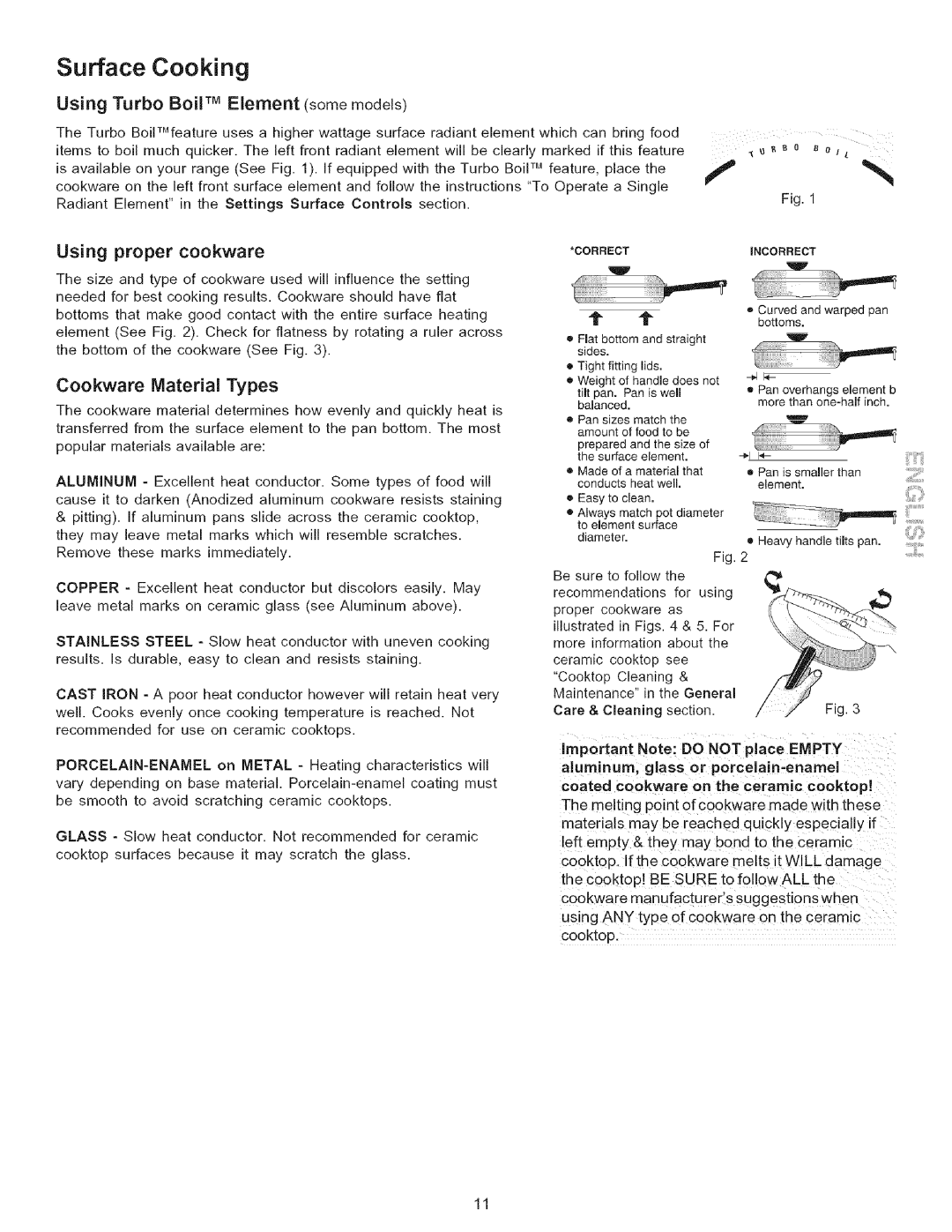
Surface | Cooking |
|
|
|
|
|
|
|
|
|
|
|
| |
Using Turbo Boil TM Element (some models) |
|
|
|
|
|
|
|
|
| |||||
The Turbo BoiFMfeature uses a higher wattage surface radiant element which can bring food |
|
|
| |||||||||||
items to boil | much | quicker. | The | left | front radiant element | will | be | clearly | marked | if this | feature | _98B | 0 | B O/ L |
is available on your | range | (See | Fig. | 1). If equipped with | the | Turbo | Boil | TM feature, | place | the | f |
| N | |
|
|
| ||||||||||||
cookware on the left front surface element and follow the instructions "To Operate a Single |
| Fig. | 1 | |||||||||||
Radiant Element" in the Settings Surface Controls section. |
|
|
|
|
| |||||||||
|
|
|
|
|
|
| ||||||||
Using proper cookware
The size and type of cookware used will influence the setting needed for best cooking results. Cookware should have fiat bottoms that make good contact with the entire surface heating element (See Fig. 2). Check for flatness by rotating a ruler across the bottom of the cookware (See Fig. 3).
Cookware Material Types
The cookware material determines how evenly and quickly heat is transferred from the surface element to the pan bottom. The most popular materials available are:
ALUMINUM - Excellent heat conductor. Some types of food will cause it to darken (Anodized aluminum cookware resists staining
*CORRECT
1" t
®Flat bottom and straight sides.
•Tight fitting lids.
®Weight of handle does not
tilt pan. Pan is well balanced.
®Pan sizes match the amount of food to be
prepared and the size of the surface element.
®Made of a material that conducts heat well. Easy to clean.
iNCORRECT
o Curved and warped pan bottoms.
4,1 I_
•Pan overhangselement b more than
÷1 I'_
•Pan is smaller than element.
&pitting). If aluminum pans slide across the ceramic cooktop, they may leave metal marks which will resemble scratches. Remove these marks immediately.
® Always match pot diameter | iii |
to element surface |
|
diameter. | ® Heavy handle timtspan. |
| |
| Fig. 2 |
Be sure to follow the |
|
COPPER - | Excellent | heat conductor | but | discolors | easily. May | recommendations | for using |
leave metal | marks on | ceramic glass | (see | Aluminum | above). | proper cookware | as |
|
|
|
|
|
| illustrated in Figs. 4 & 5. For | |
STAINLESS STEEL - Slow heat conductor with uneven cooking results. Is durable, easy to clean and resists staining.
CAST IRON - A poor heat conductor however will retain heat very well. Cooks evenly once cooking temperature is reached. Not recommended for use on ceramic cooktops.
more information | about the |
| ||
ceramic | cooktop | see |
| |
"Cooktop | Cleaning | & |
| |
Maintenance" in the | General |
| ||
Care & Cleaning | section. | Fig. 3 | ||
vary depending on base material.
GLASS - Slow heat conductor. Not recommended for ceramic cooktop surfaces because it may scratch the glass.
Important Note: DO NOT place EMPTY aluminum, glass or
11
